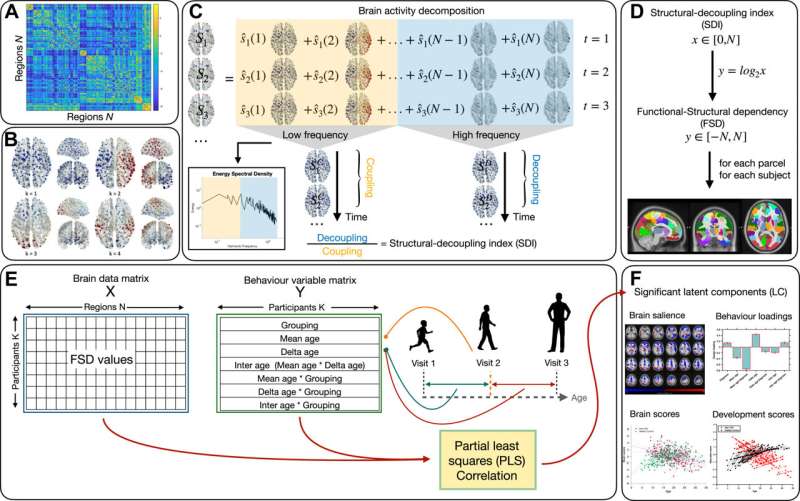This article has been reviewed according to Science X's editorial process and policies. Editors have highlighted the following attributes while ensuring the content's credibility:
fact-checked
trusted source
proofread
An over- or under-synchronized brain may predict psychosis

Is it possible to assess an individual's risk of psychosis? Identifying predictive markers is a key challenge in psychiatry. A team from the University of Geneva (UNIGE), part of the Synapsy Center for Neuroscience and Mental Health Research, studied a cohort of patients with a 22q11.2DS microdeletion—a genetic anomaly linked to psychotic disorders.
Scientists found that this population has a unique "coupling" between the structure and activity of their brain regions, with some areas losing optimal coherence during development, leading to either over- or under-coupling.
This specificity paves the way for identifying reliable risk markers. These findings are published in Biological Psychiatry: Cognitive Neuroscience and Neuroimaging.
Microdeletion of the 22q11.2DS gene is the most common genetic deletion. It affects 1 person in 2,000 and results in the absence of a small DNA sequence on chromosome 22. It can lead to heart defects and immune dysfunction, but also psychotic disorders in adolescence or adulthood in 35% of carriers.
At UNIGE, the team led by Stéphan Eliez, a full professor in the Department of Psychiatry and at the Synapsy Center for Neuroscience and Mental Health Research in the Faculty of Medicine, has been following a cohort of 300 individuals aged between 5 and 34 affected by this microdeletion for 20 years.
Almost 40% of them have developed schizophrenia. Because of its size and longevity, this Geneva cohort is a unique case study in the world and has led to the publication of numerous articles.
Atypical brain development starting in childhood
In a new study, the UNIGE team looked at the development of "coupling" between the brain regions of the individuals in this cohort, from childhood to adulthood. "Our cognitive processes are the result of interactions—or 'couplings'—between our different brain regions," explains Silas Forrer, a Ph.D. student in Stephan Eliez's team and first author of the study.
"We wanted to find out whether, in individuals with the 22q11.2DS anomaly, less efficient coupling was synonymous with an increased risk of developing psychosis."
This brain "synchronization," and especially its optimization, develops during adolescence and into adulthood. Using magnetic resonance imaging techniques, the neuroscientists observed its maturation over a period of twelve years within the cohort and a control group.
"We found that patients with the microdeletion had a persistent developmental discrepancy since childhood, with regions of hyper- and hypo-coupling throughout the brain," says Silas Forrer.
This discrepancy is particularly marked in adolescence in three brain regions in "22q11.2DS" individuals who have developed schizophrenia: the frontal cortex, responsible for voluntary motor coordination and language; the cingulate cortex, at the interface between the two hemispheres of the brain, responsible for making certain decisions; and the temporal cortex, responsible for somato-sensory functions. There is hypo-coupling in the first two and hyper-coupling in the third.
Toward identifying a reliable marker
This strong correlation between developmental discrepancy and microdeletion of the 22q11.2DS gene is a significant step towards identifying predictive markers for the disease. "The next step will be to determine how these couplings can constitute an individual 'fingerprint' of the brain, making it possible to clearly know whether an individual is more at risk than another of developing psychosis, or conversely, is protected from it," explains Stephan Eliez, who led this study.
This research is also a methodological innovation by combining observations on both the structure (morphology) and function (efficiency) of the brain to assess the developmental trajectory of a population in the context of psychiatric illnesses.
More information: Silas Forrer et al, Longitudinal Analysis of Brain Function-Structure Dependencies in 22q11.2 Deletion Syndrome and Psychotic Symptoms, Biological Psychiatry: Cognitive Neuroscience and Neuroimaging (2024). DOI: 10.1016/j.bpsc.2024.05.008


















